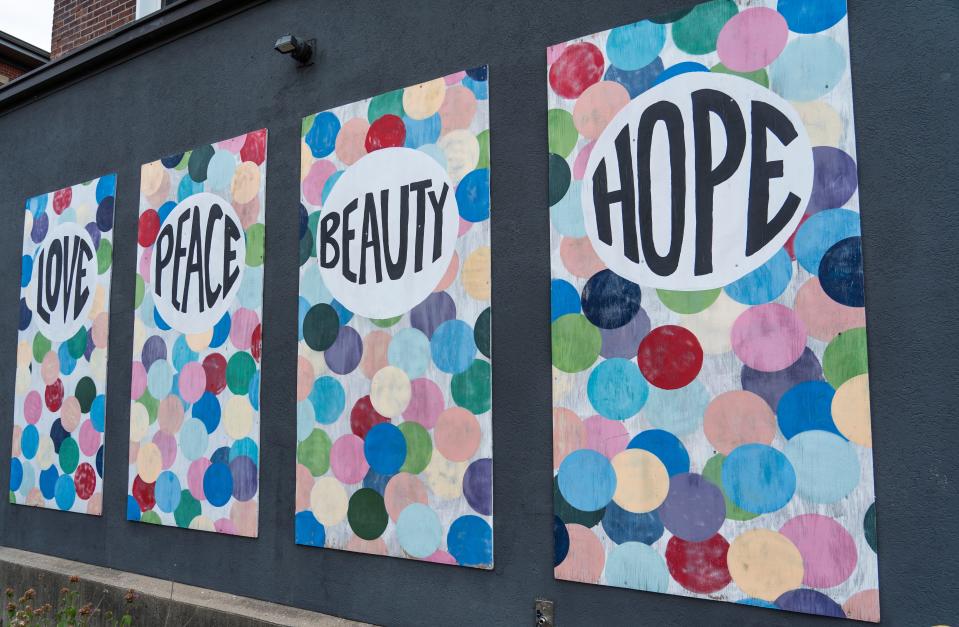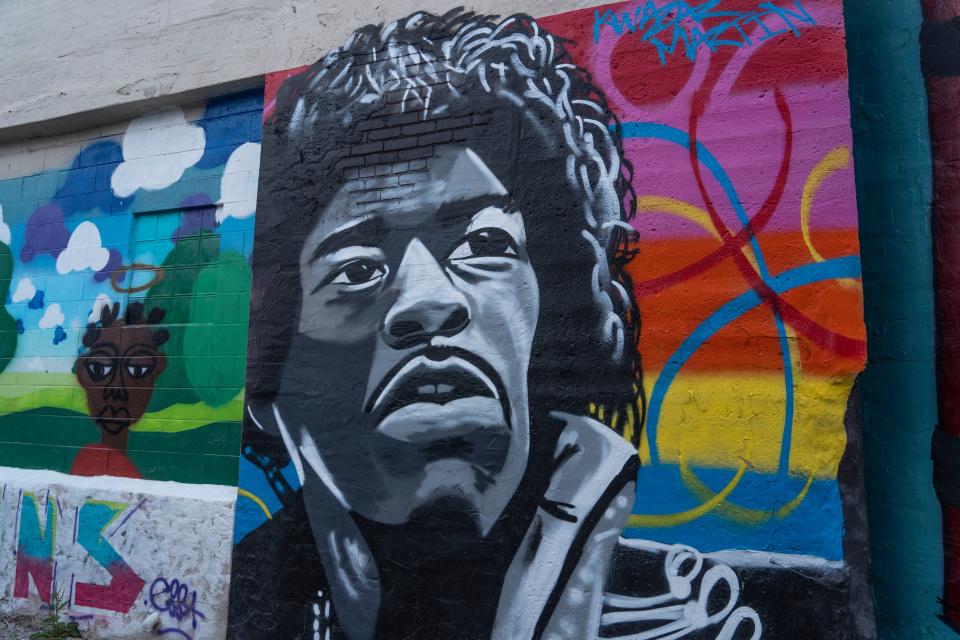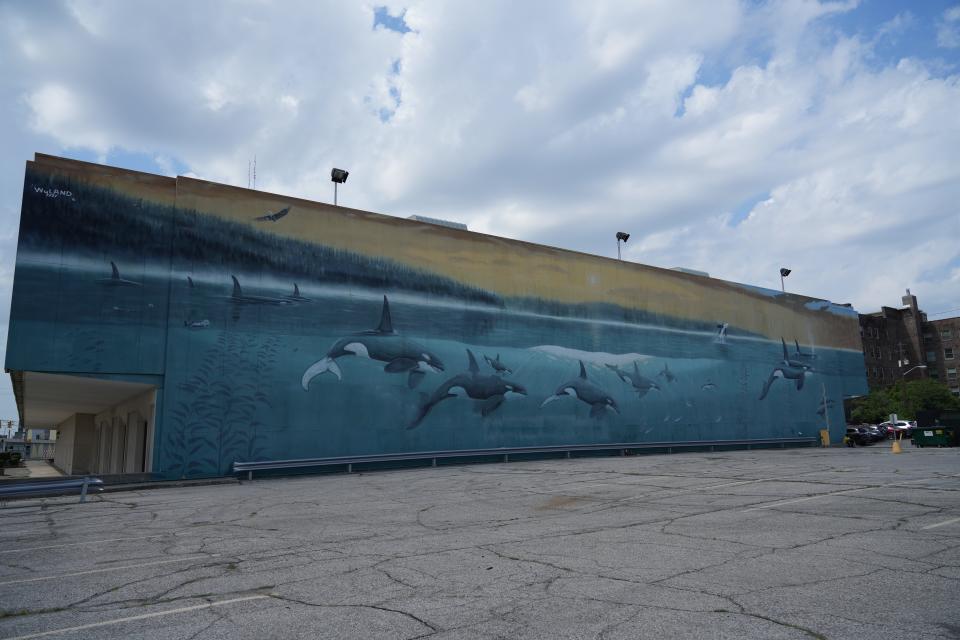New report maps 3,090 artworks you can see from public spaces in Marion County
For the first time ever, almost every single piece of public art in Marion County has been counted and mapped. Working block by block, a team scouted all of the artist-made work — including the most visible commissioned sculptures and smallest personal memorials — that someone can see from public streets and alleys.
The result is the 85-page report, called "Public Art for All: Marion County Public Art Inventory," came out Thursday. It redefines public art, which has traditionally often been considered to be large commissioned sculptures and murals that are in highly visible areas. The Indy Arts Council and City of Indianapolis Bicentennial Commission joined with Rokh Research & Design Studio, which works on cultural equity as it fosters connections between people and places, to put together the report.
The total number of works? An astounding 3,090 as of August 2021. It's a major departure from the Indy Arts Council's Public Art Directory that had 616 county public art listings at the same time.
"When a lot of people are thinking about public art, sometimes it's very narrow. But when we took on this study, some of the work we were finding didn't fit into such a narrow category, but we recognize it as art. You know it when you see it," author and lead researcher Danicia Monét Malone of Rokh said.
"So we had to broaden the definition so as to have that sense of equity in the study itself. There's no way we could have a conversation about spatial justice or spatial equity if we were looking at it through such a limited lens."

A major goal for cataloging the types of art and artists' identities, the report states, is to encourage spatial justice — which it defines as equitably distributing resources in spaces so that people of all ethnicities, genders and abilities can use them.
The inventory report was born from conversations about equity in public spaces, the role that public art plays in the environment that people build and how many artists of color were being commissioned, according to Monét Malone and Julia Muney Moore, the Indy Arts Council's director of public art. Also part of the discussions was Monét Malone's October 2020 op-ed in New America, "Racism By Design: Power Dynamics in Public Spaces."
Before the groups could take steps toward equity, they said, a baseline inventory of Marion County's art was necessary. Here are five key takeaways from the report.
Marion County has many public art types
The 3,090 pieces of art are broken down into a number of mediums, which include:
murals: 1,299
installations (large-scale, 3D constructions that include traditional and contemporary sculpture): 1,079
hand-lettered signs: 177
architectural: 158
graffiti: 109
stained glass: 80
roadside memorials: 66
tactical urbanism (low-cost, short-term interventions that are often art-based, like painted intersections): 13
So how did a team catalog all of this? They traversed about 6,500 linear miles between May and August 2021 to scout original, non-store-bought art that, from the public right of way, they could see in someone's yard, on the street, in an alley or inside an establishment. Among art they weren't able to capture was work that was in areas under construction.
Analysis: The Lume enters a year of Monet that you can enjoy, ignore or leverage
The report bills itself as the first of its kind, and Muney Moore agrees. Public art reports often, for example, exempt pieces on private property, count only what cities take care of or catalog developer projects, she said.
"To go street by street and say, 'Nothing is exempt. We're looking at literally everything' — we are the first to do that," Muney Moore said.
The team cataloged each piece by photographing it and noting its type, creator, condition and coordinates. Then they mapped all of the artworks — and cross-referenced them with other mapped county data. The results show how clumped or spread out public art is across zip codes with different incomes, ethnicities, crime, walkability and home ownership, among other factors.
Unexpected public art sites
While monuments and murals have long commanded attention, daycares and roadside memorials have quietly become a consistent source of public art. The report states daycares are among the unconventional zones that show how neighbors have created grassroots art.
"We saw so many daycares that would have their fences painted or ... exteriors activated with wood-cuttings of certain cartoon characters, etc., to ensure that their neighborhood was being seen in this bright and loving light," Monét Malone said.
Likewise, roadside memorials are personal expressions of honor toward loved ones and their history. The report found that there are three times as many of those as there are traditional monuments and statues.
"I think this is a way that people need to be able to heal and need to be able to have this visual reminder, even if it's only for a period of a few months," Muney Moore said.
Revamped at the Eiteljorg: What to see inside the Native American galleries
The Indiana Department of Transportation doesn't encourage roadside memorials because those installing and visiting them near highways are at risk for injury, Deputy Chief of Staff Scott Manning wrote in an email to IndyStar. But the department doesn't look to remove them unless it's doing maintenance or construction, he said.
Likewise, the city of Indianapolis doesn't seek to take them down but has the authority to move an unpermitted obstruction in the public right of way if it's hazardous, according to Ben Easley, chief communications officer for the Indianapolis Department of Public Works.
The creators behind the art
As the team cataloged the pieces, they also looked to see whether artists' names were present. That was the case for 537 of the works.
Of those, 18 artists created 35% of the pieces, and one person made 43. Men made almost 55% of the art, women created almost 30%, and almost 11% of the works were created by groups of people.
The report finds that the representation of known artists of different ethnicities doesn't match the population percentages in the county. For example, it states that about 16% are by artists who are Black but whose county population is 29%; and Latino artists created 8% of the works but have a county population of about 11%.

"Inviting and supporting more community members towards the creation of public art will spur engagement and generate more artistic styles," the report states in a call to action section.
Given the gap in the number of public artworks and known artists, Monét Malone said artists who would like to be identified should have more support and funding so that their signature lasts.
"Signage is not as cut-and-dried as one may think it is," Monét Malone said. "There are policies that exist in the city of Indianapolis that might make it cumbersome for an artist to put their name on their work due to size restrictions and due to the differences between it being for commercial use, is it advertising, things like that."
Public art deserts
Mapping more than 3,000 pieces of public art shows exactly where the art resides — and where it doesn't. The report found 26 census tracts that don't have artwork, 22 zones that don't have artwork within a mile, and six zones that make less than 80% of the area median income and have no artwork within a mile. In the latter two categories, daycares, schools and residential areas have been places of artistic expression, according to the report.

Conversely, it found that the downtown zip codes 46202, 46203, 46204 and 46225 were a "public art swamp" where artworks were too populous, didn't match the demographics and didn't keep up with the area's physical changes.
With this knowledge, the report provides some recommendations to increase art and support in more areas.
How to move forward
The report's main job is to provide data and analysis that will guide decision-making about public art moving forward, Muney Moore said. In doing so, it also offers calls to action. Those include conducting a regular census of public art, supporting hyper-local efforts, and working with artists and communities of different backgrounds to create more styles of work.
The report also makes several recommendations. Among them: Support for artists would help them to document their works and display more transparency for equity and inclusion. With data showing the importance of art at daycares, schools and religious spaces, for example, the report suggests that arts organizations partner with them. And it calls for better policies to help people honor their loved ones safely with roadside memorials.
Broad Ripple theater will move: Storefront has found a new home
No central body in Marion County controls public art, so Muney Moore said the report shows a way forward for property owners and others who would like to put up and maintain work. The Indy Arts Council can provide resources, she said.
"We would love to be able to use this as a way to elevate the importance of public art and to have a little bit more ... consistency to just have those conversations that lead to consistency of policies, particularly around maintenance," Muney Moore said.
Monét Malone said Rokh is in discussions with the Arts Council about how to add the work they found to the Public Art Directory while taking care not to disclose work of an especially private nature like the roadside memorials.
The next phases will include public art walking tours, discussions about investment, campaigns to help artists and city officials understand who is creating the work, and an evaluation of how accessible the work is to those who use wheelchairs, scooters and other ways of traveling the streets.
Looking for things to do? Our newsletter has the best concerts, art, shows and more — and the stories behind them
Contact IndyStar reporter Domenica Bongiovanni at 317-444-7339 or d.bongiovanni@indystar.com. Follow her on Facebook, Instagram or Twitter: @domenicareports.
This article originally appeared on Indianapolis Star: Report maps Marion County artworks you can see from public spaces

